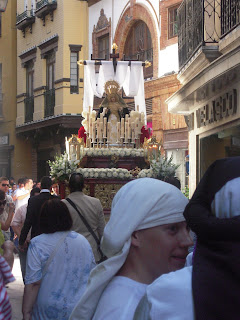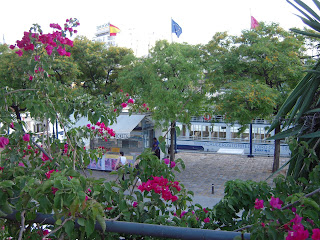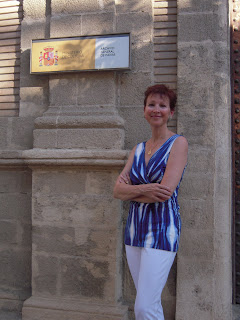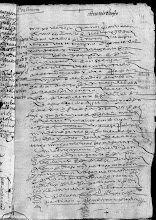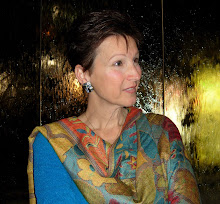After a satisfying day in the archivo (I arrived at 8:15 and left at 3) and a siesta, Billy and I went wandering in Sevilla. I wanted to go to the Giralda (I can't believe we haven't been yet) but it closes at 5, so, camera in hand, we began to walk. Thank the technology gods for digital cameras! We've been gone for 21 days and I have 1,643 photos. Okay, I do tend to take multiple shots of the same thing, but still ...
It's so difficult to cull through the myriad fabulous things I'd like to share with you; this evening I'll just concentrate on three of them. They are the earthly and the ethereal.
The Dress (the earthly)The first time we walked down our street and I looked in the store windows, I knew I wanted to buy a flamenco dress and a fan. Spanish women are feminine, and they use beautiful fans with regularity ... it's so hot in southern Spain. I love the way these women look, sitting on the train or in a restaurant, talking, and fanning themselves offhandedly with a lovely lace fan. Hmmm. It seems wherever I go, I pick up a personal habit. The first time I was in Italy (1996), I saw Italian women wearing fishnet stockings with their business suits. I loved the look and began wearing fishnets years before they became trendy in the U.S., as they are now. I think I'm going to have to start carrying a beautiful fan.
But about the dress. Flamenco dresses are uber-feminine. They are festooned with ruffles, bows, laces and fringe. Many of them are bright. Fuschia! Chartreuse! Tangerine! Scarlet! Some are, I confess, a bit tacky for my taste. Many of them are handmade, and they don't appear to come in multiple sizes. When I look in the store windows, I see row after row of individual dresses ... only one of each kind. I think one must choose the dress one wants and have it altered. I have only been window shopping thus far ... I'm not sure my Spanish language or knowledge of the culture is adequate to venture into one of these stores so soon.
But I found the one I want. Actually, Spencer found it. He pointed it out to me in a window and I gasped ... it is so beautiful. This dress has the price displayed on a discreet paper "tent" ... €1,500 or approximately USD 2,067.73. Well, I can dream, can't I??? I wish I were brave enough to go in and ask to try it on. Isn't it gorgeous?

The Helato (earthly/ethereal)
Right up the cobblestone street from The Dress is Dr. Francis' favorite heladeria; we were in the mood, so we stopped in (before dinner ... it's the only way I ever eat dessert). Helato is gelato ... sherbet ... Italian ice. It's refreshing and cool on hot Sevillano days like today, and this particular place will make special flavors for you if you ask. But why? It already has a dizzying display of flavors. Today, I ordered something with the word "Colombiana" in it (chocolate chips and coffee) and "Crema de Sevilla" (lemony) ... yum! Bill had naranja (orange) and plantana (banana). Two small cups (each cup is a very generous scoop ... and you can mix flavors) is €5,20.

There are little tables outside where you can sit to watch the scooters roaring down the cobblestone street, and the pretty mamas strolling their beautifully dressed babies.
This is one of three cases ... that equals at least 42 flavors!

They even carve fruit into flowers ... these "flowers" are watermelons.
The Friar (the ethereal)
We'd barely finished our helatos when we bumped into a church: la Iglesia Franciscana de San Buenaventura. Unlike the Giralda, this one was open ... prior to mass (misa) at 7:30. "Let's go in!" I urged Billy. Oh, I love old European churches so much! They're like a perfect present. I admire the outside first, and anticipate what's inside. It seems so often when I open them up by stepping inside, the church is so lovely and heavenly it brings tears to my eyes. This one did. Just look at its Baroque beauty:

While I was quietly walking around looking at each of the chapels and the elaborately-dressed statues of Jesus, Mary and various saints, Bill concentrated on looking for the patron, Buenaventura. A friar sitting in an open confessional spoke to Bill in Spanish as he approached. I could see them talking together across the church, and then Bill followed the monk through a curtained door. I followed too.
The priest, Fray Tómas Patero, was an absolute joy. Using our halting Spanish, we told him that we lived in the United States (he wanted to know exactly where ... and was it near Cuba?), and that I was a student of history and religion working in the archivo in Sevilla. We asked him if there was an image or statue of the patron, and he told us about St. Francis of Assisi and his follower, Buenaventura ... who lived in his heart. He took us into the garden of the convent, and turned on the fountain for us when I asked if I could take a photo:
He even posed for pictures with Billy and me, holding my hand and then kissing me on both cheeks when we left:
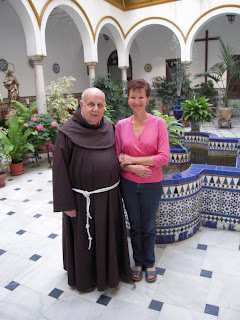
For me, this was an incredible gift ... a moment in time with a man who has committed his life to God, taking vows of poverty, chastity and obedience. The memory of his kindness to us ... two earnest American tourists ... is something I will always cherish.

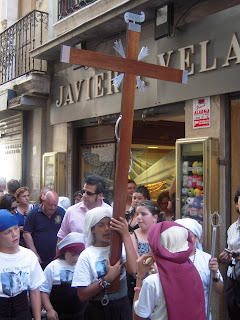


 As soon as I could, I stepped into the street to see who stood on the balcony, but I wasn’t able to really photograph the little girls I glimpsed in their flamenco dresses. However, I was able to surreptitiously photograph an enchanting baby girl parked in a stroller across the narrow street. Isn’t she adorable?
As soon as I could, I stepped into the street to see who stood on the balcony, but I wasn’t able to really photograph the little girls I glimpsed in their flamenco dresses. However, I was able to surreptitiously photograph an enchanting baby girl parked in a stroller across the narrow street. Isn’t she adorable? After the paso passed me on its way to another plaza or its home church, the band marched exuberantly through the narrow street. Then ... it was over. The crowd disbursed and the magic vanished; all that remained were the rose petals in the street.
After the paso passed me on its way to another plaza or its home church, the band marched exuberantly through the narrow street. Then ... it was over. The crowd disbursed and the magic vanished; all that remained were the rose petals in the street.

